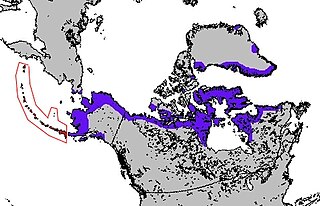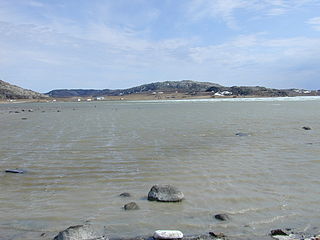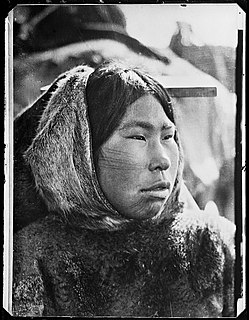
The Inuit languages are a closely related group of indigenous American languages traditionally spoken across the North American Arctic and to some extent in the subarctic in Labrador. The related Yupik languages are spoken in western and southern Alaska and in the far east of Russia, but are severely endangered in Russia today and spoken only in a few villages on the Chukchi Peninsula. The Inuit live primarily in three countries: Greenland, Canada, and the United States.

The Eskimo–Aleut languages, Eskaleut languages, or Inuit-Yupik-Unangan languages are a language family native to Alaska, the Canadian Arctic, Nunavik, Nunatsiavut, Greenland and the Chukchi Peninsula, on the eastern tip of Siberia. It is also known as Eskaleutian, Eskaleutic or Inuit–Yupik-Unangan.

Inuktitut syllabics is an abugida-type writing system used in Canada by the Inuktitut-speaking Inuit of the territory of Nunavut and the Nunavik region in Quebec. In 1976, the Language Commission of the Inuit Cultural Institute made it the co-official script for the Inuit languages, along with the Latin script.

A digraph or digram is a pair of characters used in the orthography of a language to write either a single phoneme, or a sequence of phonemes that does not correspond to the normal values of the two characters combined.

Inuinnaqtun, is an indigenous Inuit language of Canada and a dialect of Inuvialuktun. It is related very closely to Inuktitut, and some scholars, such as Richard Condon, believe that Inuinnaqtun is more appropriately classified as a dialect of Inuktitut. The governments of the Northwest Territories and Nunavut recognise Inuinnaqtun as an official language in addition to Inuktitut. The Official Languages Act of Nunavut, passed by the Senate of Canada on June 11, 2009, recognized Inuinnaqtun as one of the official languages of Nunavut.

Inuktitut, also Eastern Canadian Inuktitut, is one of the principal Inuit languages of Canada. It is spoken in all areas north of the tree line, including parts of the provinces of Newfoundland and Labrador, Quebec, to some extent in northeastern Manitoba as well as the Northwest Territories and Nunavut. It is one of the aboriginal languages written with Canadian Aboriginal syllabics.
The Inuvialuit (ɪnˈuviˌaluət) or Western Canadian Inuit are Inuit people who live in the western Canadian Arctic region. They, like all other Inuit, are descendants of the Thule who migrated eastward from Alaska. Their homeland - the Inuvialuit Settlement Region - covers the Arctic Ocean coastline area from the Alaskan border, east through the Beaufort Sea and beyond the Amundsen Gulf which includes some of the western Canadian Arctic Islands, as well as the inland community of Aklavik and part of the Yukon. The land was demarked in 1984 by the Inuvialuit Final Agreement.
The Yupik languages are the several distinct languages of the several Yupik peoples of western and south-central Alaska and northeastern Siberia. The Yupik languages differ enough from one another that they are not mutually intelligible, although speakers of one of the languages may understand the general idea of a conversation of speakers of another of the languages. One of them, Sirenik, has been extinct since 1997.

Canadian Aboriginal syllabic writing, or simply syllabics, is a family of abugidas used to write a number of indigenous Canadian languages of the Algonquian, Inuit, and (formerly) Athabaskan language families. They are valued for their distinctiveness from the Latin script of the dominant languages and for the ease with which literacy can be achieved; indeed, by the late 19th century the Cree had achieved what may have been one of the highest rates of literacy in the world.
The Inuit language, like other Eskimo–Aleut languages, exhibits a regular agglutinative and heavily suffixing morphology. The language is rich in suffixes, up to 700 per dialect, making words very long and potentially unique. For example, in Nunavut Inuktitut:

Inuttitut, or Inuttut is a Canadian dialect of Inuktitut. It is spoken across northern Labrador by Inuit people, whose traditional lands are known as Nunatsiavut.

Taloyoak or Talurjuaq, formerly known as Spence Bay until 1 July 1992; is located on the Boothia Peninsula, Kitikmeot, in Nunavut Canada. The community is served only by air and by annual supply sealift. Taloyoak may mean "large blind", referring to a stone caribou blind or a screen used for caribou hunting. The community is situated 460 km (290 mi) east of the regional centre of Cambridge Bay, 1,224 km (761 mi) northeast of Yellowknife, Northwest Territories. Taloyoak is the northernmost community in mainland Canada.

Kugaaruk, formerly known as Pelly Bay until 3 December 1999, is located on the shore of Pelly Bay, just off the Gulf of Boothia, Simpson Peninsula, Kitikmeot, in Canada's Nunavut territory. Access is by air by the Kugaaruk Airport and by annual supply sealift. Kugaaruk means "little stream", the traditional name of the brook that flows through the hamlet.

Umingmaktok is a now abandoned settlement located in Bathurst Inlet in the Kitikmeot Region of the Canadian territory of Nunavut. The community was previously known as Bay Chimo and the Inuit refer to the community as Umingmaktuuq.

The Netsilik Inuit (Netsilingmiut) live predominantly in the communities of Kugaaruk and Gjoa Haven of the Kitikmeot Region, Nunavut and to a smaller extent in Taloyoak and the north Qikiqtaaluk Region. They were, in the early 20th century, among the last northern indigenous peoples to encounter missionaries from the south.
A tetragraph is a sequence of four letters used to represent a single sound (phoneme), or a combination of sounds, that do not necessarily correspond to the individual values of the letters. In German, for example, the tetragraph tsch represents the sound of the English digraph ch. English does not have tetragraphs in native words, but chth is a true tetragraph when found initially in words of Greek origin such as chthonian.
This article discusses the phonology of the Inuit languages. Unless otherwise noted, statements refer to Inuktitut dialects of Canada.
Inuktitut Braille is a proposed braille alphabet of the Inuktitut language based on Inuktitut syllabics. Unlike syllabics, it is a true alphabet, with separate letters for consonants and vowels, though vowels are written before the consonants they follow in speech. It was published in 2012 by Tamara Kearney, Manager of Braille Research and Development at the Commonwealth Braille and Talking Book Cooperative. The book ᐃᓕᐊᕐᔪᒃ ᓇᓄᕐᓗ The Orphan and the Polar Bear was the first work transliterated into Inuktitut Braille.












